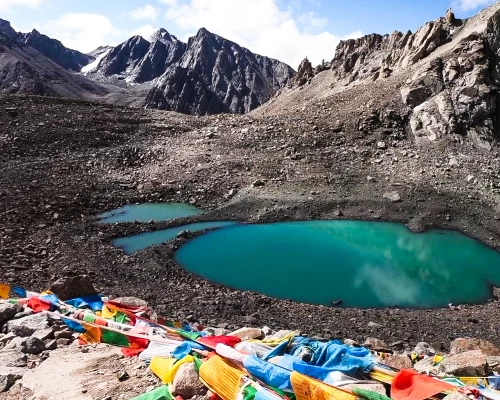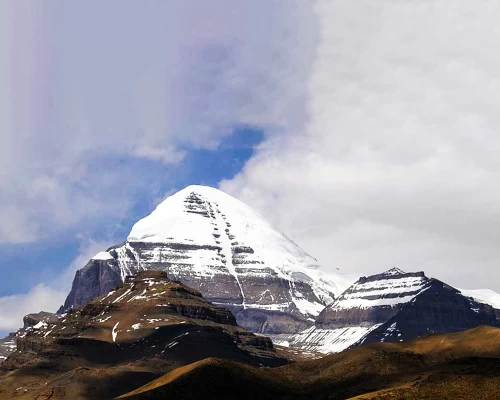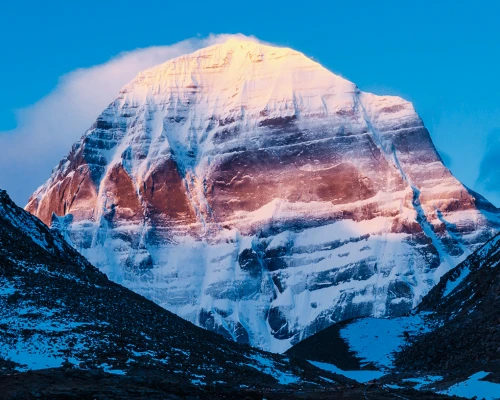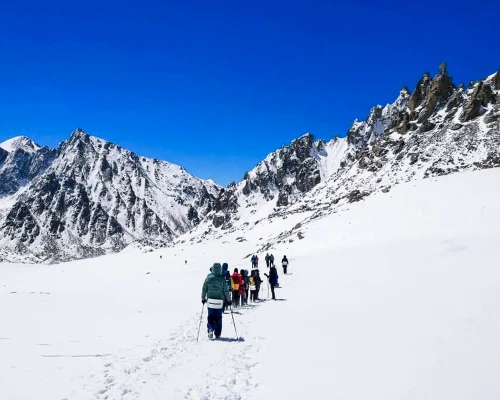Nestled in the heart of the Himalayas, Mount Kailash stands as an iconic spiritual emblem revered by Hindus, Buddhists, Jains, and Bon practitioners. Its sheer majesty and symmetry have earned it a place of profound significance in multiple faiths. For Hindus, it is believed to be the residence of Lord Shiva, the destroyer and transformer in the Hindu pantheon. Buddhists consider it sacred as the residence of Demchok, an important deity, while Jains view it as Astapada, where their religion's founder, Rishabhadeva, attained spiritual liberation. Its cultural and spiritual magnetism draws pilgrims seeking divine blessings.
Mansarovar Lake, cradled among the Himalayan peaks, offers a spiritual oasis and mirror to the sky's hues. Its crystalline waters are believed to hold cleansing properties for the soul, and pilgrims engage in rituals on its serene shores to attain spiritual purity. The Mansarovar Kora, a circumambulation of the lake, signifies spiritual renewal and is a practice observed across different faiths, fostering a sense of unity in diversity.
Embarking on the Kailash Mansarovar Yatra from Nepal, your journey begins with your arrival at Kathmandu's Tribhuvan International Airport. After settling into your hotel, the next day offers a chance to explore Kathmandu's cultural gems, including Swayambhunath Stupa, Pashupatinath Temple, Boudhanath Stupa, and Kathmandu Durbar Square. Your journey begins with a drive from Kathmandu to Dhunche or Syabrubesi. the following day you will drive to Kerung County and continue the drive to Saga, perched at 4,540 meters, you proceed onward to the sacred Lake Mansarovar, nestled at 4,558 meters, where spiritual rituals and serenity await. An inspiring kora around Mansarovar precedes your drive to Darchen, the starting point for the Mount Kailash trek. The trek itself unfolds over two days: the first sees you hiking to Deraphuk at 4,920 meters, while the second demands crossing the formidable Dolma-La Pass at 5,600 meters before reaching Zuthul Puk. As the trek culminates, you return to Darchen, the journey back to Saga. The tour concludes with a return drive to Kathmandu, and on the final day, you bid farewell, departing with memories of a pilgrimage filled with spiritual significance, physical challenges, and breathtaking landscapes. Throughout, maintaining your well-being and respecting local customs remain paramount.
Major Highlights of Kailash Mansarovar Yatra
Dolma- La Pass
Dolma-La Pass is the roughest and the highest point you reach in the Kailash Mansarovar Yatra from Nepal, located at an elevation of 5.630 meters above sea level. Crossing the Dolma-La Pass is a physically demanding journey that requires a good level of fitness, however can still be climbed and offers astonishing views of Mt. Kailash itself.
Mansarovar Lake
Mansarovar Lake stands as a major highlight of the Package for Kailash Mansarovar Yatra, captivating pilgrims with its serene aura. Nestled among the gorgeous Himalayas, this pristine freshwater lake is believed to hold spiritual healing for the soul. Many pilgrims around the world visit Mansarovar Lake and perform rituals and prayers on the shores seeking peace and purity. The mirror-like water on the lake reflects the changing hues of the sky creating an extremely delicate atmosphere.
Mount Kailash Kora Trek
Within the Kailash Mansarovar Yatra, the Mount Kailash Kora Trek is a major highlight that gives pilgrims a life-changing tour of this renowned summit. The trek offers both physical difficulties and spiritual insights. The adventure continues from the pass to ZuthulPhuk, where participants experience a unique emotional and physical transformation. The Kailash Kora Trek captures the essence of pilgrimage by traveling the inner landscapes of the self in addition to encircling a mountain, leaving pilgrims with memories of obstacles overcome, connections made, and spiritual awakenings.
Highlights
- Discover unique cultural heritages and architectural gems during the Kathmandu City Tour,
- Traverse the diverse landscapes from the vibrant Kathmandu to the tranquil Kailash Mansarovar Trek
- Participate in sacred rituals by the Mansarovar Lake,
- Witness the beauty of nature’s creation and reflect on your spiritual journey,
- Pass your journey through the difficult Dolma La Pass- the highest point of the tour,
- Challenge yourself with a trek around the sacred Mt. Kailash,
- Engage in the Mansarovar Kora, uniting pilgrims from different backgrounds,
- Traverse through rocky terrains to reach Deraphuk.
Best Time for Kailash Mansarovar Yatra
Summer months, (May to September), are the best time for the Kailash Mansarovar Yatra. The weather is generally more pleasant during this time, with clearer skies and warmer temperatures. Since July is often rainy due to the monsoon season, the yatra is typically scheduled from May to June and then from August to September. The expedition will be more practical and accessible as the snow on the routes and passes will have been melted throughout these months.
Fitness for Mount Kailash Mansarovar Yatra Nepal
A high level of physical fitness is required for the Kailash Mansarovar Yatra. The journey includes long hiking sections with steep ascents and descents, frequently over difficult terrain. As the trail ascends to a higher altitude, altitude sickness can be a problem. Pilgrims should exercise regularly, concentrating on cardiovascular and strength training, prior to their journey. It is essential to consult with a doctor, especially for people with pre-existing health issues, before beginning the yatra.
Difficulty for Mount Kailash Mansarovar Yatra
The Kailash Mansarovar Yatra is regarded as a moderate to difficult tour for a number of reasons. The trek involves long stretches of trekking at high altitudes, which can cause altitude-related symptoms like fatigue and shortness of breath. The Dolma La Pass, which is physically demanding due to its steep, rocky terrain and high altitude, is one of the challenging points of the tour.
The difficulty can be increased by the unpredictable climate and distant location. The yatra should be undertaken with a spirit of perseverance and dedication, and pilgrims should be mentally ready to face these challenges. Acclimatization, physical fitness, and enough planning are essential for navigating the challenges.







.webp)

 based on 5 reviews
based on 5 reviews
